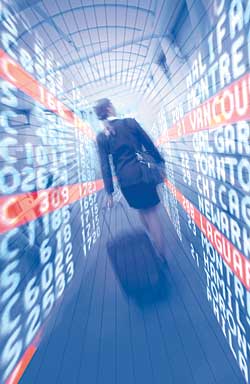Flying Solo
Sun Country Airlines finds cost-effective airline security system
- By Sharon Steinhoff-Smith
- Sep 01, 2006
 SECURITY is something the airlines take very seriously, even more so after 9/11. Sun Country Airlines is no exception. And like other carriers, Sun Country is facing cost challenges greater than ever before. As a result, even basic security tools, such as identification cards, must be produced as cost effectively as possible.
SECURITY is something the airlines take very seriously, even more so after 9/11. Sun Country Airlines is no exception. And like other carriers, Sun Country is facing cost challenges greater than ever before. As a result, even basic security tools, such as identification cards, must be produced as cost effectively as possible.
Until recently, Sun Country Airlines had been outsourcing the production of its ID cards. Bottemiller became dissatisfied with the cost and the delay.
Sun Country Airlines, purchased by MN Airlines in 2002, is a privately held, low-cost, low-fare airline that flies Boeing 737 aircraft to 25 tourist destinations, including Dallas, Las Vegas, Los Angeles, Orlando, Fla., San Francisco, Mexico and the Virgin Islands. The airline uses photo ID cards for visual identification of its 700 U.S. employees with a proximity feature that enables on-site access control. Today, there is one version of the card for general employees and another for ground security coordinators, with additional versions possible in the future, according to Kevin Bottemiller, Sun Country Airlines IT project manager.
Changing Things Up
Until recently, Sun Country Airlines had been outsourcing the production of its ID cards. Bottemiller became dissatisfied with the cost and the delay.
"Sometimes we would wait a week or more for the service bureau to print and mail our cards to us," he said. "We had to take our turn getting into the queue."
This caused a problem for the human resources manager, as well, who worried about both turnaround time and security liability.
As a key decision maker, Bottemiller knew there had to be a better way to accomplish the task of providing photo ID cards for Sun Country Airlines.
"I thought we could accomplish our objectives more quickly and less expensively by producing the cards ourselves," he said.
So he did his homework and obtained information on several printers.
"I liked the Fargo HDP600 because it was cost-effective and simple to use. It also gave us over-the-edge printing, which we preferred because of its appearance," he said.
"Sun Country prints a dark card, and I wanted to maintain a high-class appearance," said Angie Lueschen, IdentiSys, who sold the Fargo printer to Sun Country. "High-definition printing technology ensures brighter, truer colors because it prints the images onto the underside of special film, which is then fused onto the card."
The HDP600 is particularly appealing for companies wanting to upgrade the security levels of their ID cards. It prints, encodes and laminates high-security ID cards with embedded electronics, such as smart chips or proximity antennae, in one pass. This is important because it avoids the security risk of encoding vital information or access onto the wrong card. Because HDP technology prints the images onto film, not directly onto the card, it prints even over surface irregularities caused by embedded electronics without damaging either the card or the printhead.
A Favorable Reaction
Bottemiller said he was impressed with the reliability of the printer.
"When it first arrived, we printed 650 cards and were unable to use only two," he said. "That's pretty impressive, especially since we were printing onto expensive proximity cards. We didn't want to waste any."
Bottemiller also liked the fact that the HDP600 was compact, functional and allowed for future technology, including biometrics and smart cards.
"The printer was ordered with a magnetic encoder and smart card module to allow for future biometrics expansion," he said.
Nonetheless, Bottemiller did encounter resistance from his managers about making a change.
"Change was difficult," Lueschen said. "Kevin had to go through approval with internal departments and with the Federal Aviation Administration, but what sold the deal was the cost and added security. Everyone seems happy with the results."
According to Bottemiller, the previous cards cost $5 each. Sun Country Airlines can now produce a card for .65 cents. Even after adding proximity functionality, the airline is spending less than $4 per printed card.
Today, there are three people in Sun Country's human resources department trained to use the printer, enabling the airline to produce cards immediately when needed. Sun Country Airlines is flying solo these days, at least when it comes to printing its photo ID cards, and according to Bottemiller, it's the only way to fly.
This article originally appeared in the September 2006 issue of Security Products, pg. 20.